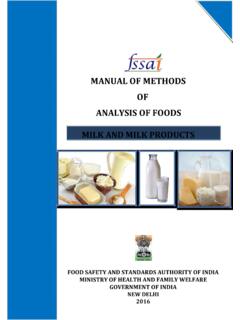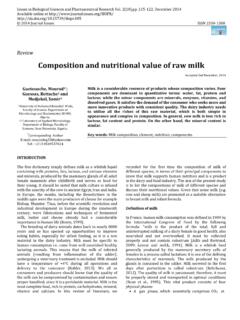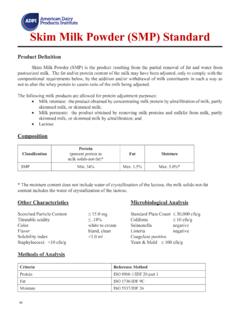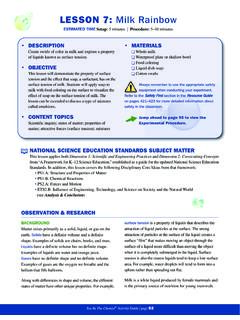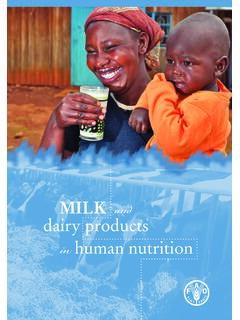Transcription of ABM Clinical Protocol #8: Human Milk Storage Information ...
1 ABMP rotocolABM Clinical Protocol #8: Human milk Storage Information for Home Usefor Full-Term Infants, Revised 2017 Anne Eglash,1 Liliana Simon,2and The Academy of Breastfeeding MedicineA central goal of The Academy of Breastfeeding Medicine is the development of Clinical protocols, free fromcommercial interest or influence, for managing common medical problems that may impact breastfeedingsuccess. These protocols serve only as guidelines for the care of breastfeeding mothers and infants and do notdelineate an exclusive course of treatment or serve as standards of medical care.
2 Variations in treatment maybe appropriate according to the needs of an individual mothers may encounterunforeseenreasons for separation from their infants, but more oftenwomen express and store milk for planned events, lifestyleflexibility, and returning to work. Knowledge of appropriatehuman milk handling and Storage is essential for breastfeed-ing success in these situations. One study indicated that al-though most women store their milk as recommended,*12%heated their milk in a microwave, and 17% rinsed bottlenipples/teats with only water before reuse,1which may reducethe milk s biological properties and increase risk of contam-ination, respectively.
3 Another study showed that neonatalnurses knowledge and practice of breast milk collection andstorage were adequate, however, there was inadequacy re-lated to discarding, storing, and thawing breast milk is a fresh, living food with many antioxidant,antibacterial, prebiotic, probiotic, and immune-boostingproperties in addition to nutrients. Although some of thesenutrients and health properties change with Storage , there isgood evidence that Human milk Storage can be safe, allowingprovision of optimal nutrition to the child when breastfeedingor immediately expressed milk is not available.
4 When directbreastfeeding is not possible, stored Human milk maintainsunique qualities, such that it continues to be the gold standardfor infant for Human milk Storage1. Washing: Women should wash their hands with soapand water, or a waterless hand cleanser if their handsdon t appear dirty, before milk expression. Uncleanhands may transmit viruses and bacteria, some ofwhich can cause illness. Studies show that Human milkcontaining fewer bacteria at the time of expressiondevelops less bacterial growth during Storage and hashigher protein levels compared to milk that has anabundance of 5 Additional hand hygiene andcleaning of the breasts before expression are not (IIB) (Quality of evidence [levels of evidenceIA, IB, IIA, IIB, III, and IV] is based on levels ofevidence used for the National Guidelines ClearingHouse7and is noted in parentheses.)
5 2. Hand or Pump: milk expression can be achieved by handor by a pump. As long as the appropriate steps are takenfor hand cleansing and cleaning of pump parts as per thepump manufacturer s instructions, there does not seem tobe a difference in milk contamination with pumpingversus hand ,9(IIB, IV) There is no need todiscard the first few drops of milk with initiating milkexpression. This milk is not more likely to be contami-nated than milk that is subsequently found that milk expressed at home appears to havemore bacterial contamination than milk expressed at thehospital, possibly related to equipment at home ortransport, not related to personal (IIB)3.
6 Storage Container Choice: Several studies have beendone to evaluate a range of available Storage is a significant reduction in percent of fat and anincrease in total protein and carbohydrate concentra-tions with either glass or polyethylene, polypropylene,polycarbonate, or polyethersulfone bottles or and polypropylene containers appear similar intheir effects on adherence of lipid-soluble nutrients to thecontainer surface,11the concentration of immunoglobulin1 Department of Family and Community Medicine, University of Wisconsin School of Medicine and Public Health, Madison, of Pediatrics.
7 Pediatric Critical Care, University of Maryland School of Medicine, Baltimore, MEDICINEV olume 12, Number 7, 2017 Mary Ann Liebert, : by Sarah Reece-Stremtan from at 09/14/17. For personal use (IgA), and the numbers of viable white blood cells in thestored of polyethylene containers was asso-ciated with a marked drop (60%) of IgA12and milk sbactericidal effect when compared to Pyrex, a type oftempered containers were associated with amarked decline in cell count and cell viability whencompared to polyethylene14and (IIB)There has been concern about possible contamina-tion of milk stored in polypropylene bags because of therisk of contamination by puncturing the (IV)
8 However, one study showed no difference betweencontamination and fat loss when comparing hard andsoft polypropylene , plastic bagsused for Human milk Storage should be sturdy, sealedwell, and stored in an area of the freezer where damageto the bag would be minimized. (IIB) Containers madewith bisphenol A, which is found in several plasticcontainers including baby bottles, should be avoidedbased on strong evidence of its adverse effects as anendocrine should be caution aboutthe use of bottles with bisphenol S, a bisphenol A al-ternative, as it may also have deleterious effects, al-though this is not well established in the milk should not be stored in hospital plasticspecimen Storage containers such as those used for ur-ine or other bodily fluids because there is insufficientevidence regarding their chemical safety and effects oninfants health.
9 19only food grade plastic containersshould be used for Human milk Storage . (IV)4. Care of Containers:Containers for Human milkstorage andbreast pump milk collection kits must be completely dis-mantled, washed in hot soapy water and rinsed or washedin a dishwasher,8and should always be thoroughly airdried or dried with paper do not need to besterilized. If soap is not available, then boiling water ispreferable. (IIB) Chemical disinfection is not ideal, as thedisinfectant can be easily deactivated and could exposeinfant to unnecessary risk of both inadequately cleancontainers and residual chemical (IV) Storage of Human Milk1.
10 Freshly expressed Human milk may be stored safely atroom temperature (10 29 C, 50 85 F) for some pe-riod of time. Studies suggest different optimal timesfor room temperature Storage because conditions varygreatly in the cleanliness of milk expression techniqueand the room temperature. Warmer ambient tempera-tures are associated with faster growing bacterialcounts in stored milk . For room temperatures rangingfrom 27 Cto32 C (29 C=85 F), 4 hours may be areasonable ,21,22 For very clean expressed milkwith very low bacterial counts, 6 8 hours at lowerroom temperatures may be reasonable, but it is best tochill or refrigerate as soon as possible if the milk willnot be used during that ,23 25(IIB)2.



